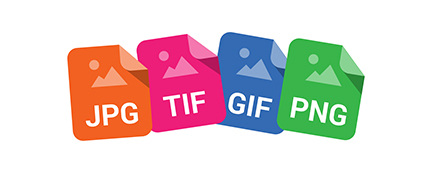All image files are not created equal.
Depending on where and how you plan to use an image, different types of files are needed. A basic understanding of the different types of image files – and when and where to use them –will ensure seamless collaboration and efficient delivery.
Four common image file types:
JPEG or JPG (Joint Photographic Experts Group)
- Widely used format
- Best for web on a white background
- Smallest file size when saved at 72 DPI
- Easily attaches to emails or uploaded to platforms with file size restrictions
TIFF or TIF (Tagged Image File Format)
- Highest quality
- Largest file size
- Best for print applications
- Files are often too large to attach to an email or use on the web
GIF (Graphic Interchange Format)
- Used to create animations for the web
- Not suitable for print
- Limited color options
PNG (Portable Network Graphics)
- Exclusively for web use, not print application
- Best option when you need a transparent background
- Better image quality than JPEGs
Do you need help developing an effective image file strategy? Give us a call at 847.541.4626 or send an email to [email protected].

